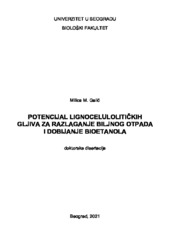Приказ основних података о дисертацији
Potencijal lignocelulolitičkih gljiva za razlaganje biljnog otpada i dobijanje bioetanola
Potential of lignocellulolytic fungi for plant residues degradation and bioethanol production
| dc.contributor.advisor | Stajić, Mirjana | |
| dc.contributor.other | Ćilerdžić, Jasmina | |
| dc.contributor.other | Brčeski, Ilija | |
| dc.contributor.other | Vukojević, Jelena | |
| dc.creator | Galić, Milica | |
| dc.date.accessioned | 2022-05-25T07:03:16Z | |
| dc.date.available | 2022-05-25T07:03:16Z | |
| dc.date.issued | 2021-12-30 | |
| dc.identifier.uri | https://eteze.bg.ac.rs/application/showtheses?thesesId=8549 | |
| dc.identifier.uri | https://fedorabg.bg.ac.rs/fedora/get/o:25559/bdef:Content/download | |
| dc.identifier.uri | https://plus.cobiss.net/cobiss/sr/sr/bib/61469961 | |
| dc.identifier.uri | https://nardus.mpn.gov.rs/handle/123456789/19036 | |
| dc.description.abstract | Gljive su najefikasniji organizmi u konverziji lignoceluloznog otpada do fermentabilnih šećera zbog njihovog složenog enzimskog sistema. Međutim, jedna vrsta retko može da sintetiše sve enzime potrebne za razgradnju ovog materijala, pa se ko-kultivacijom dve ili više vrsta može doći do optimalnog sistema. Ciljevi ovog istraživanja su bili određivanje potencijala odabranih makro- i mikromiceta za razlaganje lignoceluloznog otpada iz poljoprivrede i šumarstva radi utvrđivanja najefikasnijeg delignifikatora odnosno producenta celulaza, kao i njihove kompatibilnosti za fermentaciju supstrata u ko-kulturi. 27 vrsta makromiceta i 11 vrsta mikromiceta kao i 8 vrsta otpada je testirano u ovoj studiji. Kolorimetrijskim metodama i izoelektričnim fokusiranjem okarakterisani su proučavani enzimi dok je stepen depolimerizacije supstrata određen standardnim metodama. Pšenična slama je bila najoptimalniji supstrat za sintezu ligninolitičkih enzima a Pleurotus pulmonarius HAI 573 se pokazao njenim visoko efikasnim i selektivnim degraderom (50,4% lignina; 3,8% celuloze i 15,3% hemiceluloze). Trichoderma harzianum BEOFB 1230m je visoko efikasan producent pre svega ksilanaza (4184,2 U/L) i endocelulaza (2299,7 U/L) i mineralizator hemiceluloze (33,0%) i celuloze (23,9%). U poređenju sa mono-kulturama P. pulmonarius i T. harzianum, u njihovoj ko-kulturi zabeležene su više aktivnosti ksilanaza (10553,4 U/L), endocelulaza (2911,8 U/L), egzocelulaza (224,5 U/L) i β-glukozidaza (464,6 U/L). Rezultati istraživanja su pokazali postojanje kompatibilnosti odabranih vrsta za sintezu enzima i fermentaciju lignoceluloze u ko-kulturi što ukazuje na mogućnost njihove primene u procesu dobijanja bioetanola. | sr |
| dc.description.abstract | Lignocellulose has huge potential as a raw material for the production of food, feed, biofuels etc. Fungi are the most efficient organisms in the conversion of lignocellulose to fermentable sugars due to their complex enzyme system. However, one species can rarely synthesize all required enzymes, so co-cultivation of two or more species can lead to an optimal system. The goals of this study were to determine potential of selected macro- and micromycetes for the depolymerization of agro-forestry residues to determine the most efficient delignifier and cellulase producer, as well as their compatibility for substrate fermentation in co-culture. 27 species of macromycetes and 11 species of micromycetes, as well as 8 lignocellulosics were tested in this study. The studied enzymes were characterized by colorimetric methods and isoelectric focusing, while the degree of substrate depolymerization was determined by standard methods. Wheat straw was the most optimal substrate for the synthesis of ligninolytic enzymes and Pleurotus pulmonarius HAI 573 proved to be its highly efficient and selective degrader (50.4% lignin; 3.8% cellulose and 15.3% hemicellulose). Trichoderma harzianum BEOFB 1230m is a highly efficient producer primarily of xylanase (4184.2 U/L) and endocellulase (2299.7 U/L) and a mineralizer of hemicellulose (33.0%) and cellulose (23.9%). Compared with mono-cultures of P. pulmonarius and T. harzianum, their co-culture showed higher activities of xylanases (10553.4 U/L), endocellulases (2911.8 U/L), exocellulases (224.5 U/L) and β-glucosidases (464.6 U/L). These results showed the existence of compatibility of selected species for enzyme synthesis and lignocellulose fermentation in co-culture, which indicates possibility of their application in bioethanol production. | en |
| dc.format | application/pdf | |
| dc.language | sr | |
| dc.publisher | Универзитет у Београду, Биолошки факултет | sr |
| dc.rights | openAccess | en |
| dc.rights.uri | https://creativecommons.org/licenses/by-nc/4.0/ | |
| dc.source | Универзитет у Београду | sr |
| dc.subject | gljive belog truljenja | sr |
| dc.subject | white-rot fungi | en |
| dc.subject | ligninolytic enzymes | en |
| dc.subject | cellulolytic enzymes | en |
| dc.subject | cellulase-producing fungi | en |
| dc.subject | delignification | en |
| dc.subject | lignocellulose residues | en |
| dc.subject | co-cultivation | en |
| dc.subject | ligninolitički enzimi | sr |
| dc.subject | celulolitički enzimi | sr |
| dc.subject | gljive producenti celulaza | sr |
| dc.subject | delignifikacija | sr |
| dc.subject | lignocelulozni otpad | sr |
| dc.subject | ko-kultivacija | sr |
| dc.title | Potencijal lignocelulolitičkih gljiva za razlaganje biljnog otpada i dobijanje bioetanola | sr |
| dc.title.alternative | Potential of lignocellulolytic fungi for plant residues degradation and bioethanol production | en |
| dc.type | doctoralThesis | |
| dc.rights.license | BY-NC | |
| dcterms.abstract | Стајић, Мирјана; Ћилерджић, Јасмина; Брчески, Илија; Вукојевић, Јелена; Галић, Милица; Потенцијал лигноцелулолитичких гљива за разлагање биљног отпада и добијање биоетанола; Потенцијал лигноцелулолитичких гљива за разлагање биљног отпада и добијање биоетанола; | |
| dc.identifier.fulltext | http://nardus.mpn.gov.rs/bitstream/id/142783/Izvestaj_Komisije_12189.pdf | |
| dc.identifier.fulltext | http://nardus.mpn.gov.rs/bitstream/id/142782/Disertacija_12189.pdf | |
| dc.identifier.rcub | https://hdl.handle.net/21.15107/rcub_nardus_19036 |



